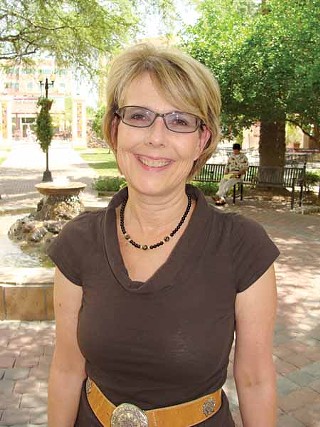Is the Marshall Foundation more of a retail-property-development company, or a philanthropic nonprofit agency? Well, it's inseparably both, according to Jane McCollum, director of the foundation. McCollum's job is to manage and develop the Main Gate Square property west of the UA, and, with the help of her board, to donate funds to UA scholarships and those in need living in Pima County. For more information, visit www.maingatesquare.com.
A big part of your job is working as a property manager, not just as a director of a nonprofit.
That's because all of our money comes from the management of our assets. We get no outside donations, and we have no family trust. So there's no money that just sits in a bank growing. We have to manage these assets properly and appropriately. And the (Internal Revenue Service) determines how much we give away: It's 5 percent of the fair market value of my real estate.
Some people are still nostalgic for what was here before Main Gate was redeveloped. Do you understand where they're coming from?
Sometimes. It is a push and pull for me, personally. I'm a local business person. I shop at local businesses. You won't find me at Wal-Mart. I'm not that person; I'm going to go to a local restaurant. I'm going to go to a local retailer. But I understand what a recognized name brings to an area. ... People would be surprised to know that 70 percent of my stores are locally owned, or they are franchises operated by people who live here. ... From that perspective, we don't always give credit and credence to that. But I've had a lot of people say, "It's so Pei Wei-ified." I'll say, "That's an interesting word, but 70 percent of my businesses are local; did you know that?"
Who started the foundation?
Louise Marshall was our founder. She was the first female professor at the university in 1899. She came from a background where her family was not wealthy, but then her dad discovered the formula for patent leather. She had both perspectives. Her parents understood the need to give back to the community and to help those who were less fortunate than you. ... She wanted the Marshall Foundation to do that when she founded it in 1930. She felt that it needed to help youth, to help education and to help those less fortunate. At some point, the bylaws were amended to include some things like arts and culture, and that it had to be limited to Pima County.
Is there still a plan to build a movie theater within Main Gate Square?
Yes. The foundation looks at itself as a partner with the University of Arizona. The UA wants a theater for its media-arts program. So we sort of feel an obligation to help with that. The secondary thing is that it would obviously change the dynamic of summer for us and Christmas. The challenge is that a movie theater, while not the same as a grocery store, does not always pay rent that supports the building of a new building. The challenge ... is finding something that can be financed that works for the Marshall Foundation, because when it comes out of the ground, it has to break even from the get-go.
And you feel you've been able to do that?
We've been identifying all of the tenants that are going to be in before (constructing the planned new building). We've identified our largest retailer on the bottom, and that would be the Aveda Institute. They told us, "We want to build where you're building. We want our students to feel like they are getting a university experience as well." Now we're working on costs, and this is a good time to build. It's a little bit cheaper.
What theater company is coming in?
I can't tell you until we sign the lease.
Are you guys looking forward to the light rail that will link you with downtown?
I think one of the reasons I was hired is that our board and our development consultants knew of my involvement in downtown when I was manager of La Placita Village. I've always been involved. I was on the original Rio Nuevo Citizens Advisory Committee. ... We're now connected to downtown and the neighborhoods, and that's a great thing. I think the more people come down to all of these places, the more they will understand that the urban core is not a scary place. It's really where there is a lot of life.





